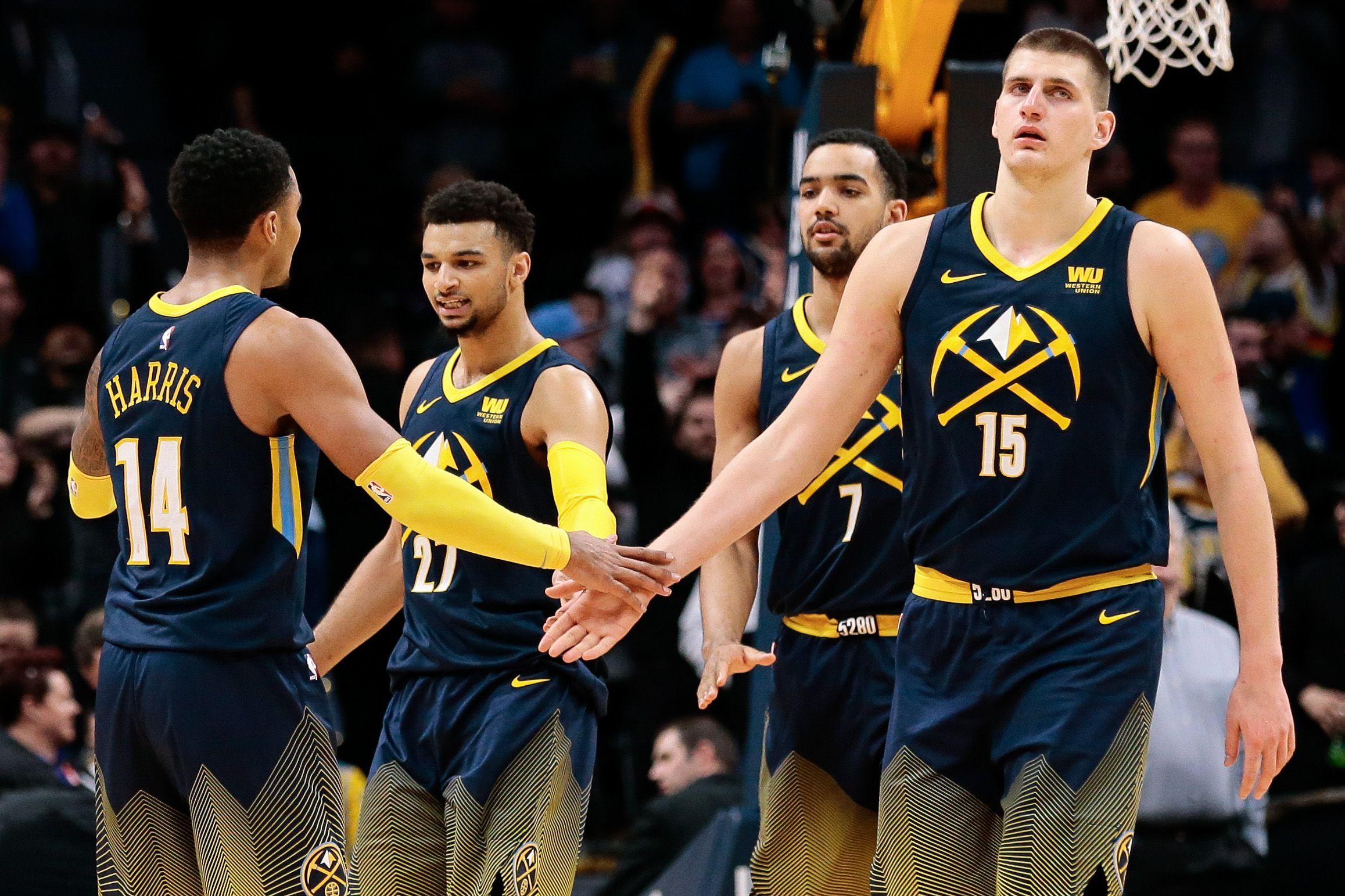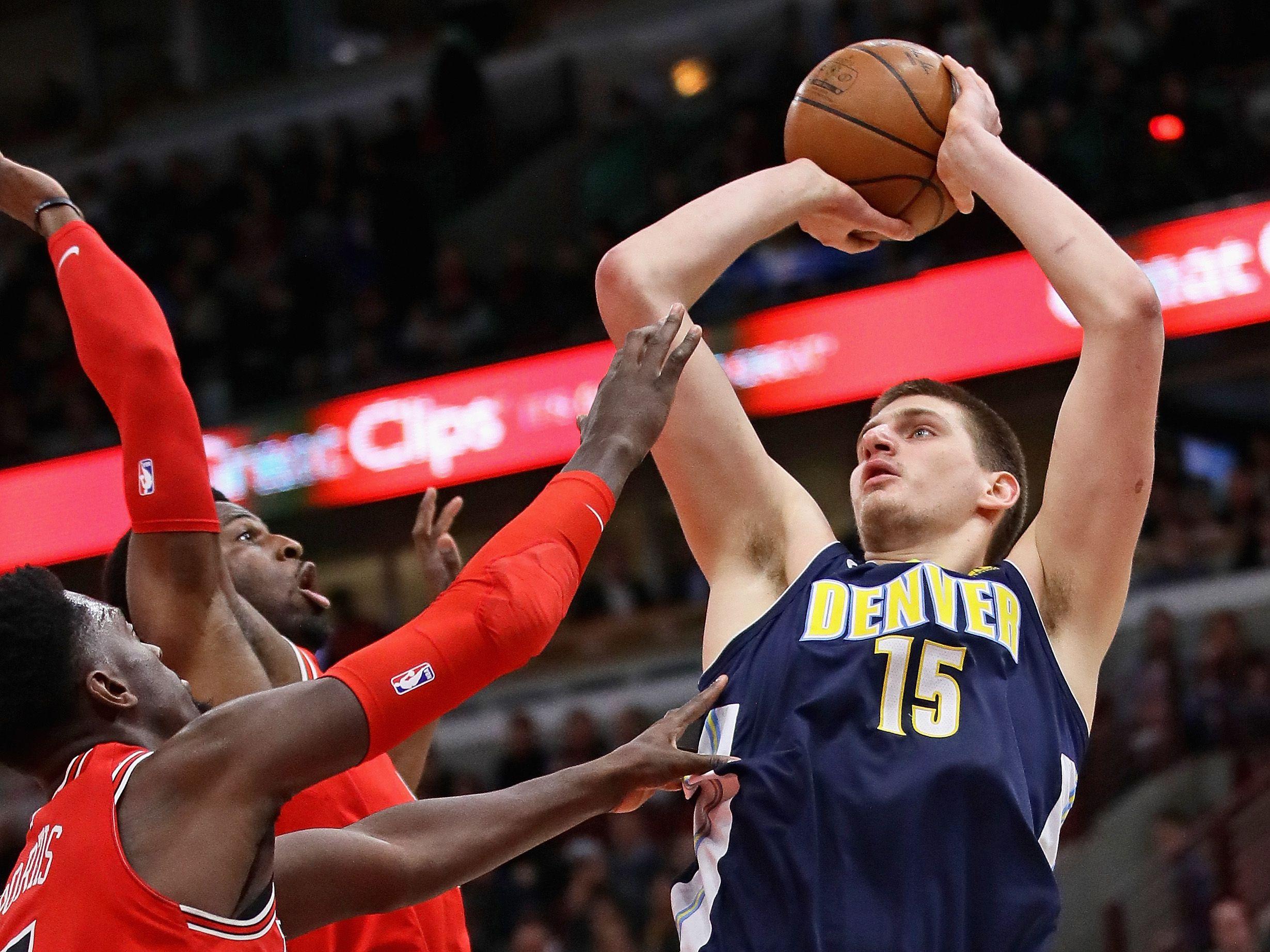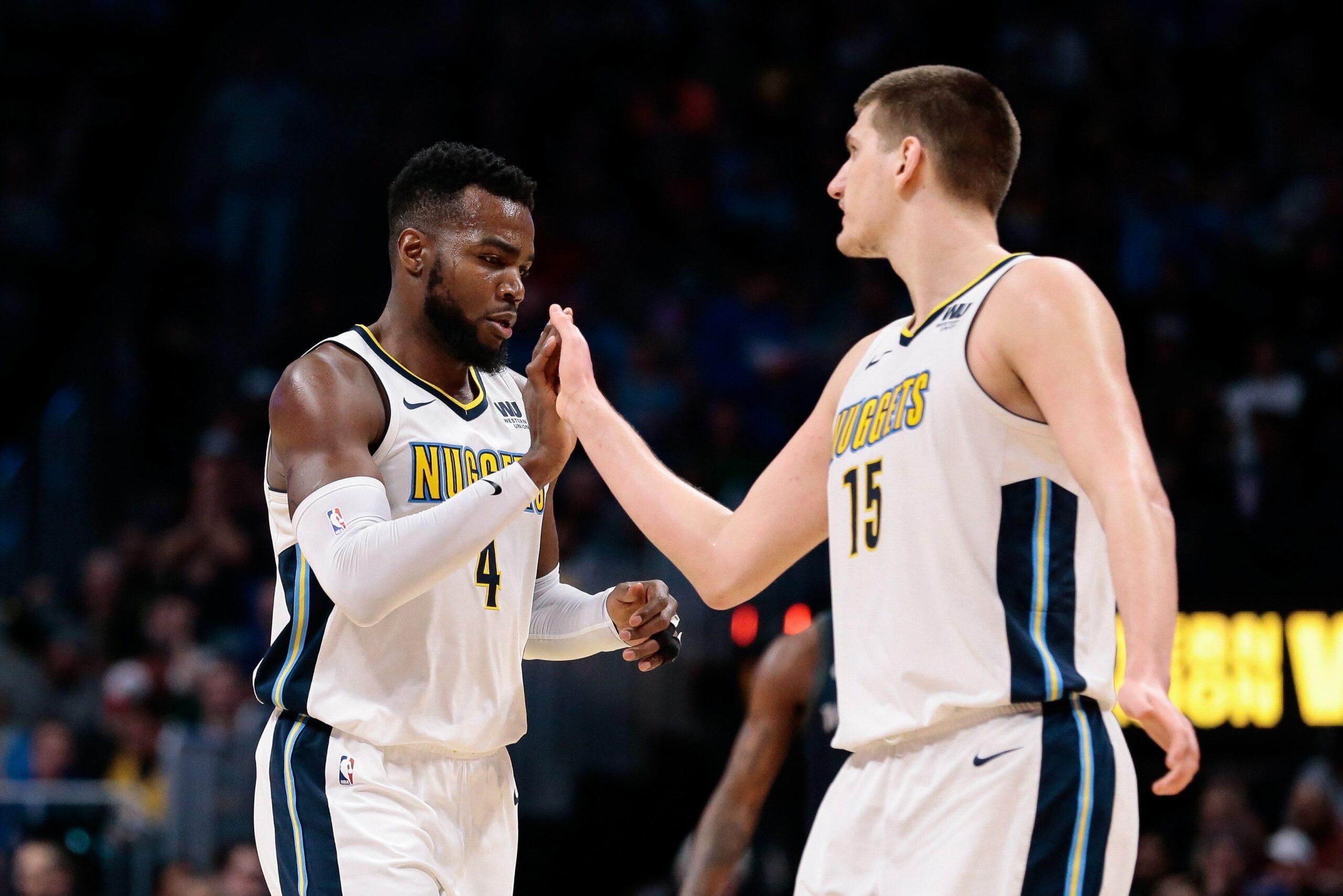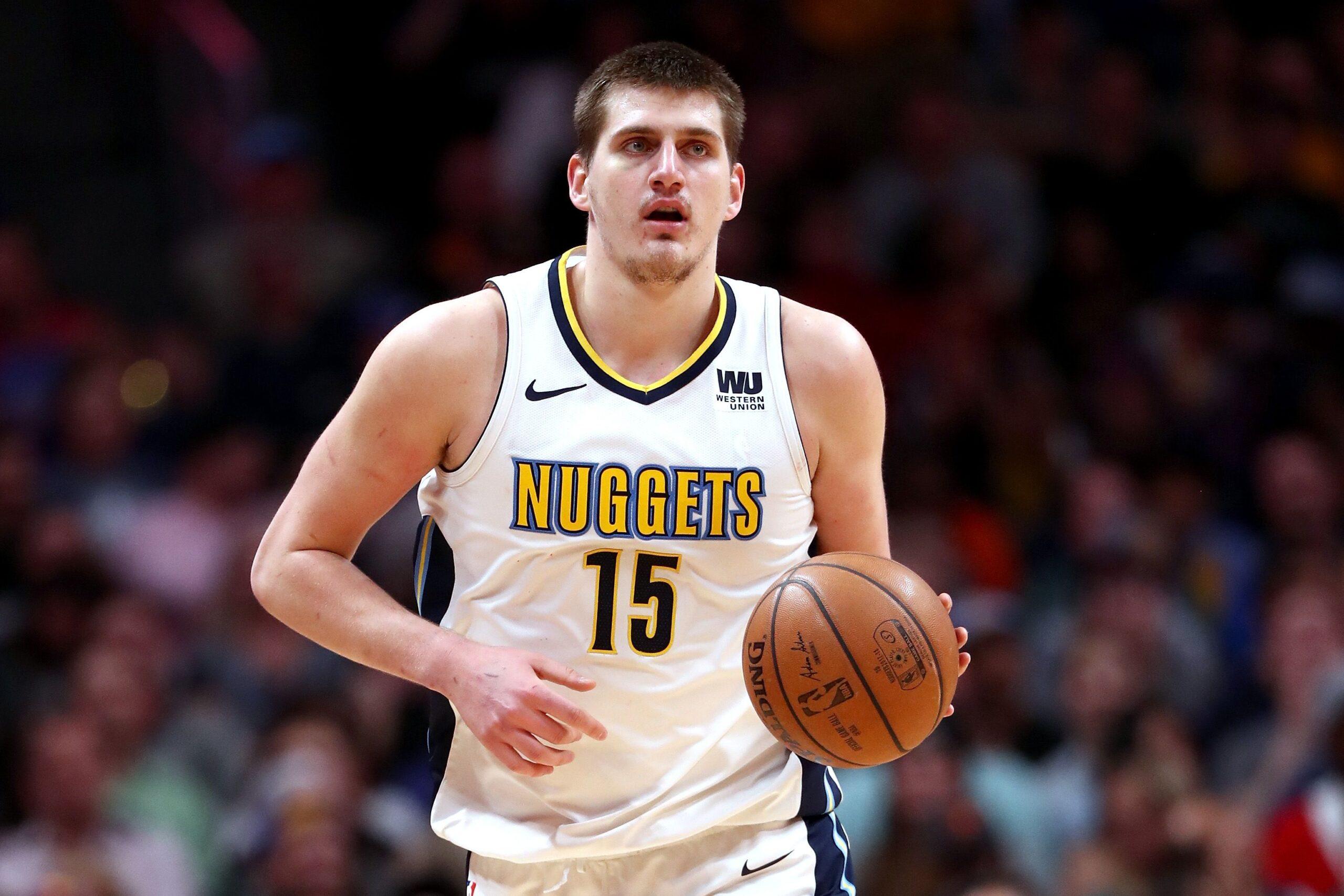Talk to anyone around the Denver Nuggets about Nikola Jokic and it feels like they are letting you in on a big secret. Their eyes light up when you ask about the 23-year-old big man from Serbia, like they know something the rest of the NBA doesn’t. Jokic is already one of the best centers in the league, but people in Denver don’t think he’s anywhere close to his ceiling.
Paul Millsap didn’t know much about his new frontcourt partner when he signed with the Nuggets last offseason. One year later, he’s a true believer. “I always heard about Nikola, but Denver is a small market and I was on the East Coast [in Atlanta],” Millsap told me after the Nuggets’ first training camp practice in San Diego. “When I got here, I saw firsthand how unbelievable a basketball player he is. It was a huge surprise, for sure.”
Jokic showed a glimpse of his future at the end of last season, when he averaged 24.0 points on 53.8 percent shooting, 11.5 rebounds, and 6.4 assists over the last 18 games. His game is more than just the brilliant passing he’s known for. He had three games of 35-plus points, four games of 15-plus rebounds, and four triple-doubles in that stretch. Denver was in a dogfight for the final playoff spots in the Western Conference, and Jokic carried it to a win-or-go-home game in Minnesota on the final night of the season, which the team lost in overtime, 112-106. His 35-point, 10-rebound performance would have been the stuff of legend had the Nuggets won. He played 46 of the game’s 53 minutes. Denver was plus-7 in his 46 minutes on the floor and minus-13 in his seven minutes off.
“Sometimes I don’t think [Jokic] realizes how good he is. And how great a player he is,” Nuggets head coach Mike Malone said at media day in Denver. “There were times last year where we’d talk about other big men in the NBA. He would say, ‘I don’t think I’m as good as this guy or that guy,’ and I’d look at him like, ‘Are you crazy?’”
Jokic doesn’t carry himself like an elite player. He still acts like an obscure second-round pick, deflecting media attention and avoiding the spotlight as much as he can. When the Nuggets signed Millsap to a three-year, $90 million contract last summer, Jokic thought he would take a backseat to the new guy. “Nikola and Paul were just getting to know each other when Paul broke his wrist [in November],” Malone said. “And when Paul came back at the end of February, there was a very uncomfortable period of ‘Whose team is this? Is it Nikola’s team? Or is it Paul’s?’ I eventually pulled Nikola into my office and told him: ‘Stop trying to make everyone happy. Stop being so passive. You’re our best player. Embrace it.’”
Jokic played his worst basketball of the season when Millsap rejoined the starting lineup March 2. Jokic scored 22 points total over the next three games, bottoming out with a four-point performance in a loss to Dallas. Everything changed the following night against Cleveland. Jokic had a near triple-double (36 points, 13 rebounds, and six assists), and never looked back. He averaged 12.6 field goal attempts over the first 72 games and 19.2 per game over the final 10, and he tied a career high (25) in the finale against the Wolves.
“I tried to bring [Millsap] back [after his return]. Get him comfortable. He just said to go play your game,” Jokic told me one afternoon at the San Diego State practice center.
Jokic was first among equals in Denver. He led the team in usage rate last season (24.2), but he was one of seven rotation players with a rate higher than 20. With Millsap, Gary Harris, Jamal Murray, and Will Barton also initiating the offense, Jokic had a smaller role than most other top scorers around the league. He made the most of a relatively limited number of opportunities. Of the 31 players who averaged at least 18 points per game last season, Jokic was 27th in usage and eighth in true shooting percentage (60.2).

“We really clicked once we all realized that Nikola is our best player. We are going to play through him. He is the centerpiece of all that we do. And everybody else has to fit it around him. It makes things a lot easier and simpler,” said Malone.
The Nuggets made a massive financial commitment (five years, $148 million) to Jokic in the offseason. It’s the most money they have paid any player since Carmelo Anthony. Owner Stan Kroenke opened up the checkbook to keep the team together. Denver has given big money to Harris (four years, $84 million) and Barton (four years, $53 million) in recent years, and they will have to pay Murray, the no. 7 overall pick in the 2016 draft, soon as well. Heads could roll if they don’t break a five-year playoff drought come April. Malone and GM Tim Connelly are both in the final seasons of their contracts.
Jokic is the key. The Nuggets have an interesting collection of young talent, but he is the one player with the tools to elevate their franchise. “[Jokic] can do whatever he wants to do. It’s not just about his scoring. It’s everything. His rebounding. His playmaking. Anything he wants to do, he can do it,” said Barton. “He just needs to keep being more assertive. Keep coming into his own. Embracing who he is. Which is one of the best players in the NBA.”
Now they just need to convince him of that.
Jokic didn’t do much to celebrate his newfound wealth. Soon after signing his max contract in early July, he went back to his hometown of Sombor, a town of fewer than 100,000, two hours north of Belgrade. It was the same routine that he has done every summer since coming to the league: work in the gym, hang out with friends and family, and tend to his stable of horses.
When a reporter at media day asked Jokic whether he could buy some swagger with all his money, he claimed not to know what swagger is. When asked about LeBron James signing with the Lakers, he expressed amazement that one player could single-handedly change a franchise. People around the Nuggets think Jokic has done the same thing, but you would never hear that from him. “It’s not like that. We have the same team, same core, since I came here,” he said. “We just need a little bit of help, and I think we’ll be good.”
Jokic was never supposed to be a franchise player. He fell all the way to the no. 41 overall pick in the 2014 draft because teams were afraid that he couldn’t keep up with the speed of the game. He’s a doughy center in a league getting smaller and faster every season. Jokic has transformed his body since his days as a 300-pound 17-year-old in Serbia, but he still seems out of place in comparison with the world-class athletes at his position. He’s dominating in an era when many guys with his physical profile are struggling to stay in the league.
“[Jokic] can do whatever he wants to do. It’s not just about his scoring. It’s everything. His rebounding. His playmaking. Anything he wants to do, he can do it. He just needs to keep being more assertive. Keep coming into his own. Embracing who he is. Which is one of the best players in the NBA.” — Will Barton
Jokic is built like a traditional big man, but has the statistical profile of an All-Star point guard. He led the Nuggets in true shooting percentage (60.3) and assist percentage (28.6) last season. At 7 feet and 250 pounds, with a 7-foot-3 wingspan, he is the tallest player to ever have a season with those statistical benchmarks, and one of only six players above 6-foot-5 to have done it. The other seven? LeBron James, Magic Johnson, Penny Hardaway, Michael Jordan, and James Harden.
His production is historic on many levels. Jokic is one of only six players in NBA history to average at least 18 points, 10 rebounds, and six assists over an entire season. The other five are Oscar Robertson (three times); Larry Bird, Wilt Chamberlain, and Russell Westbrook (all twice); and Kevin Garnett (once). The average age of those players in the 10 seasons they reached those numbers is 27, and they averaged 20.1 field goal attempts per game in those seasons. Jokic did it at 22 while averaging only 13.5. His über-efficiency in a smaller role indicates that he could succeed in a much bigger one.
The people in Denver aren’t the only ones high on Jokic. ESPN’s RPM formula projects him as the most impactful player in the league this season. His 18-game hot streak at the end of last season may not be an aberration. It may just be who he is. Jokic can bring the ball up the floor himself and initiate the offense, and he can dribble into jumpers anywhere on the court. It’s almost impossible to defend a guy his size who plays so fluidly on the perimeter. There’s nothing anyone can do about a 7-footer who can make shots like this:
Jokic can dribble to a spot, use his size to create separation, and shoot over the top of any defender. And his soft touch means he needs only an inch of daylight. If the Nuggets keep feeding him the ball, and he plays with the same kind of aggressiveness, everything will fall into place.
“[I told Nikola to] just be aggressive. Be yourself. That’s being a playmaker. Whatever comes with it. Don’t look to defer to me. Go out there and do what you do,” said Millsap. “The sky is the limit. He can average a triple-double, easily, if he wanted to. And I think that’s where he’s headed.”
Most young big men have to accept a smaller role on offense when they get to the NBA because they are no longer the best player on their team. Jokic has the opposite problem. He’s a passer at heart, not a scorer. His natural instinct is to make the extra pass rather than force up a tough shot. YouTube is flooded with his assist highlights. He has the size, unselfishness, and spatial intelligence that all great passing big men share.
Jokic discovered at the end of last season that looking for his shot is the best way to help his team. His scoring ability puts pressure on the defense. If he forces the opposition to send hard doubles, he won’t need to make as many jaw-dropping passes. Malone wants Jokic to limit turnovers this season, and it’s hard to turn the ball over when you are passing to a wide-open teammate.
“Whatever is good for my team, I’m going to do that. If that means being aggressive, I’m going to do that,” Jokic told me. “I showed myself I can do that.”
Jokic will also have to be more assertive off the court. The Nuggets dumped many of their veterans (Wilson Chandler, Kenneth Faried, Darrell Arthur, and Richard Jefferson) in the offseason to clear out space under the luxury tax to re-sign Jokic and Barton. They have a young team, with only two rotation players (Millsap and Isaiah Thomas) around age 30, and a bench made up almost entirely of guys on rookie contracts. Jokic doesn’t have to be the most vocal player in the locker room, but how he conducts himself matters, both in practice and during games. “He has to be the first one in the drills. First one here. Last one to leave. Guys are going to follow him,” Millsap said.
“Nikola is an emotional player. It can be a strength, but it also can be a weakness at times,” said Malone. “He has to make sure that he is not getting frustrated or losing it. Because all of our players are looking at him.”
Denver is Jokic’s team now. He might have been the last to find out, but he won’t be able to avoid the attention for much longer.

It can be hard for a young player to accept that type of responsibility, especially one who was raised in a different culture. Jokic isn’t going to yell at someone for not living up to expectations. His passing is a reflection of his personality. His first instinct is to make others comfortable, even if it means giving up the spotlight. It’s how he was taught to play.
“You have to pass the ball in Europe. You need to play team basketball. The NBA is a little more individual,” he said.
There is a template for a soft-spoken 7-footer from across the pond assuming control of an NBA franchise. No one thought Dirk Nowitzki was an MVP-caliber player when he was 23, not even Dirk. There’s a revealing passage in Ian Thomsen’s The Soul of Basketball in which Nick Creme, one of Nowitzki’s best friends, recounts conversations he had with a young Dirk. “I’d make comments to [Dirk], kidding him, like, ‘You’re the franchise player here,’” Creme told Thomsen. “He’d always say, ‘I’m not the franchise player here. This is [Michael] Finley’s team.’”
Dirk made his first All-Star Game at 23, but at that point in his career he was the second option behind Finley, and he spent most of his time playing off Steve Nash. When Nash left in free agency in 2004, the assumption was that Dallas would fall off after losing a two-time All-Star point guard for nothing. Instead, they got better. The Mavs went from being a perennial also-ran to making the 2006 Finals. Dirk went from being considered a top-15 player, much like Jokic now, to being the MVP of the 2006-07 season.
“I eventually pulled Nikola into my office and told him: ‘Stop trying to make everyone happy. Stop being so passive. You’re our best player. Embrace it.’” — Mike Malone
Dirk was a whole new breed of 7-footer. He didn’t need to score out of the low post, and he didn’t need a guard who could set him up. He could bring the ball up the floor himself and launch 3-pointers if he needed to. It didn’t matter who his teammates were. Dirk could score at will regardless of who was around him. Dallas had a top-10 offense every season between 2000-01 (when Dirk was 22) and 2010-11 (when he was 32), even though they turned over their roster multiple times and played wildly different styles of basketball under three head coaches (Don Nelson, Avery Johnson, and Rick Carlisle).
Jokic has made a similar impact during the past two seasons in Denver. The Nuggets had the no. 17 offense in the NBA when he was a rookie averaging 21.7 minutes per game. They shot all the way up to no. 4 when he became a full-time starter the next season, and stayed in that range (no. 6) last season. He has some of the most dramatic on-court/off-court offensive numbers in the league, even though there is no shortage of talent around him in Denver:
Nuggets Offense With Jokic on the Court
Nuggets Offense With Jokic on the Bench
Jokic does it differently than Dirk. He’s a better passer, but he’s not as good an athlete as Dirk was at the same age. What the two have in common is the ability to be a one-man offense. A possession in which Jokic touches the ball will almost always end in a high-percentage shot. He can create space against any defender, and he can find the open man if the defense sends help. Unlike most big men in NBA history who scored out of the post, Jokic, like Dirk, can initiate offense from the free throw line and the 3-point line, two areas where it’s harder to send help.
The goal for the Nuggets should be to raise his usage rate as he gets older, like the Mavs did with Dirk. The big German went from a usage rate of 25.3 at age 23 to 30.0 at 27 (when he led them to the 2006 Finals), 28.9 at 28 (when he won the MVP), and 28.2 at 32 (when they won the championship). What Dallas eventually realized is that it didn’t need many big-time scorers around Dirk. Guys like Nash, Finley, Nick Van Exel, Antawn Jamison, and Antoine Walker were all replaceable in Dallas because they were taking away possessions from Dirk on offense and doubling down on his poor defense. Denver has a similarly high-powered team around Jokic, and it might have to make some equally tough decisions to build an elite squad around its star 7-footer.
Defense has killed the Nuggets in the Jokic era. They had the no. 29 defense in the NBA two seasons ago, and the no. 25 defense last season. They have actually been better defensively with Jokic on the floor, but not nearly good enough. Hearing Malone preach the importance of defense in training camp gave me flashbacks to Nelson talking about defense after Mavs teams built around Dirk and Nash had gotten run out of the playoffs the year before. A coach can do only so much. Defense is ultimately about personnel.
Playing Jokic at center puts his team at an inherent defensive disadvantage. The center is often the last line of defense, and he can’t cover for anyone. Young big men with elite physical tools have a difficult enough time mastering interior defense, much less lumbering types like Jokic. His block rate last season (2.1 percent) was 23rd among starting centers in the NBA. Jokic doesn’t check any of the boxes for an elite defensive 5: He can’t stay in front of faster players, rotate quickly enough to cut off penetration, or challenge players above the rim. He allowed opposing players to shoot 67.9 percent from the field against him when he was the primary defender, the worst mark of any player who defended at least five shots per game.
The Nuggets want Jokic to be more sound positionally. He can’t count on athleticism bailing him out when he’s out of position. He has to read the offense, anticipate what it is doing, and get himself in the right spot before the play begins. Nuggets executives have a perfect model in mind: Marc Gasol, who won Defensive Player of the Year at the age of 28 despite not having elite quickness or leaping ability.
“[Jokic] has to be a great position defender. I’m not going to say he’s the most unathletic person. He has some athleticism to him. He can move his feet. We expect him to,” Millsap said. “We expect him to be a good defender. And he will get there when he starts learning placement, where he needs to be on the defensive end. It’s a work in progress.”
However, as one executive acknowledged to me, the Grit ’N’ Grind era is long over. The Grizzlies once throttled teams with Gasol dropping back on pick-and-rolls and their perimeter players funneling penetration to him. Over the past few years, though, the increasing number of guards who shoot 3s off the dribble has made that strategy less effective. Drop a screen against James Harden, Steph Curry, Kyrie Irving, or Damian Lillard and it’s three points. Most elite teams don’t even try crowding the paint on pick-and-rolls in the playoffs. They all have centers who defend past the 3-point line, or they go smaller to find players who can.
“Everybody is switching everything,” Malone said. “Can Nikola switch onto a guard, and guard him for two to three dribbles? We worked on his body, trying to tighten his body up, worked on his footwork so that he can move a little better.”
Pick-and-roll defense is one of the weakest parts of his game. Jokic was in the 45th percentile of players leaguewide when defending the roll man, and the 50th percentile of players when defending the ball handler. He has room to improve, but his ceiling on those plays isn’t high. The Nuggets are better when they can keep him out of them.
That was one of the reasons they signed a versatile defensive big man in Millsap. Malone often switched their assignments at the end of games, with Millsap defending the primary roll man, whether they were at the 4 or the 5, and Jokic hiding on the weaker offensive player. Millsap can do it all on defense: switch screens, fight bigger players in the post, protect the rim, and quarterback the defense. The Nuggets had a net rating of plus-9.9 (and a defensive rating of 103.8) in the 869 minutes he played with Jokic last season. They would probably have made the playoffs had he played in more than 38 games.
“[Millsap] is like a panther over there,” said Jokic. “He can jump. He can defend. He’s a really good defensive player. Two-way player. To have someone behind you, it’s a good thing.”
Millsap and Jokic are a great regular-season frontcourt, but they will have issues in the playoffs out West. They don’t have the size and athleticism to deal with players like Anthony Davis, LeBron James, and Kevin Durant. It’s the same problem across their roster. The Nuggets don’t have enough length and athleticism to be a contender. Harris (6-foot-4 and 210 pounds) is their best perimeter defender. Barton (6-foot-6 and 190 pounds) is now their starting small forward, and he doesn’t have the frame to match up with bigger 3s.

That’s another lesson the Nuggets can take from the Mavs. The best teams of the Dirk era weren’t offensive juggernauts with multiple All-NBA scorers. It was the groups filled with rugged, athletic defenders like Josh Howard, Jerry Stackhouse, and Erick Dampier in the middle of the 2000s, and Shawn Marion, Tyson Chandler, and Jason Kidd toward at the end of the decade. A team with a scorer as gifted as Dirk didn’t have to play beautiful basketball. They could put waves of long and athletic players around him at every position, and count on him to bring them home on offense. Dallas was at its best with a simple division of labor. Dirk handled the offense. His teammates covered for him on defense.
Denver has missed on chances to build that type of team around Jokic. They had the no. 13 overall pick in the 2017 draft, and they acquired Trey Lyles by trading down to no. 24, one spot below where the player they wanted (OG Anunoby) was taken. Lyles could be a big-time scorer, but he doesn’t have Anunoby’s defensive potential. The Nuggets could also have taken Zhaire Smith at no. 14 in this year’s draft, instead of rolling the dice on the injured Michael Porter Jr. Zhaire and OG don’t just have cool names. They are two of the best athletes to come to the NBA in years, and both have the basketball IQ to be excellent cutters who catch lobs from Jokic, à la Gary Harris.
The Nuggets need the kinds of athletes around Jokic who can ace NFL SPARQ tests. Their most interesting rookie might be Jarred Vanderbilt out of Kentucky, the no. 41 overall pick, the same spot Jokic was taken four years ago. Vanderbilt, like Porter, was an elite recruit who fell on draft night because of massive injury red flags. At 6-foot-9 and 215 pounds, he’s a freakish athlete with the tools to guard players at all five positions. He also has point forward ability that he didn’t show at Kentucky, and his biggest weakness (lack of a jumper) won’t be an issue next to Jokic. Vanderbilt could develop into a perfect complement to Denver’s franchise player. Find a few more guys like that and they could have something special.
Building around Jokic is a fascinating experiment in basketball theory. An imaginative coach could build an offense that takes the game in new directions. Jokic doesn’t have any real historical precedents. Even Dirk is an imperfect comparison.
If Jokic has an advantage over his predecessor, it’s in timing. The current era of the NBA offers more space to operate on offense than at any point in league history. Dirk’s career high in 3s per game (4.9) came in 2002-03. He was tied for no. 13 in the league that season. The same number would have been tied for no. 67 last season. Jokic, who was all the way down at no. 126, should be shooting more 3s. He shot 39.6 percent from 3 last season on 3.7 attempts per game, way behind guys like DeMarcus Cousins (6.1), Blake Griffin and Kevin Love (5.6). The threat of the shot alone would open up so much room for his teammates.
A prime Jokic could be something we have never seen before: a volume-3-point-shooting point center. The hope for the Nuggets is that he can push the league more in the direction of the Warriors, who run a motion offense that zips the ball around, rather than the Rockets, who hold the ball and hunt for isolations. But those two teams aren’t necessarily the gantlet the Nuggets will have to run to win a championship. Jokic doesn’t have to win a title in this era of the NBA. At 23, he’s young enough to outlast it.

Jokic should be a cornerstone in Denver for the next decade, if not longer. A big man whose game is based on skill can play forever. Size and shooting ability don’t decline with age. And since Jokic rarely gets off the ground, he has a better chance of staying healthy long term than smaller players who fly through the air. Dirk has never missed a season due to injuries, and he’s still valuable at 40. He made his first All-Star Game at 24, and his last at 37, with the league shifting under his feet several times along the way. The pace of change in the NBA has picked up over the past few years, and there’s no way to know where it will go from here.
Denver has to experiment with different versions of their team around Jokic. Murray and Harris might not last the next 10 years. Malone almost certainly won’t. It’s not that he is a bad coach, anymore than Don Nelson and Avery Johnson were in Dallas. Rick Carlisle just had a better vision of how to maximize Dirk. The Mavs spent 13 seasons throwing things against the wall until something stuck. The Nuggets could do the same thing with Jokic, as long as they have a creative front office and an ownership group willing to spend money.
Jokic’s career could go in so many different directions. There will be twists and turns ahead of him that no one can predict. Dirk was drafted in 1998 and is still playing in 2018; Jokic could conceivably play at a high level in the 2030s. There are a lot of exciting young players in the NBA. Jokic is up there with any of them.

